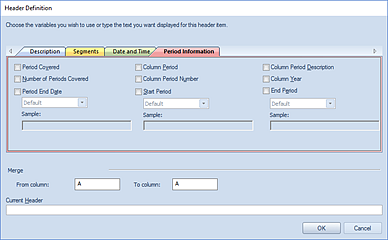
Selecting the ellipsis button on the Header or Footer row in your Report Definition’s Headers and Footers tab will return the Header or Footer Definition screen. (The Header or Footer screens contain identical options, therefore, only the Header Screen will be shown here.)
Select one or more Header or Footer code value via the checkbox and the syntax will automatically populate in the Current Header or Current Footer field in the screen and Report Definition workspace.

The available options on the Headers or Footers Definition Period Information tab include:
|
Header Value |
Header Syntax |
Information Displayed |
Example |
|
Period Covered |
@COVERED |
Displays the periods covered by the report |
“For the Three Months Ending…” |
|
Number of Periods Covered |
@PERCOVERED |
Displays a numeric value representing the number of periods covered in the report. |
“2” |
|
Period End Date: Default |
@ENDING |
Displays the period end date in the date format defined in your Options setting |
“April 30, 2014” |
|
Period End Date: Prospero Long Date |
@PROSPEROENDING |
Displays the period end date in a long date format but without the day of the week included. |
“April 30, 2014” |
|
Period End Date: System Long Date |
@LONGENDING |
Displays the period end date in weekday, month, day, and year format. |
“Monday, April 30, 2014” |
|
Period End Date: System Short Date |
@SHORTENDING |
Displays the period end date in MM/DD/YYYY format. |
“4/30/2014” |
|
Report Period |
@PERIOD |
Displays the column period. |
“April” |
|
Report Period Number |
@PERNUM |
Displays the column period as a numeric value. |
“4” |
|
Report Period Description |
@PERDESC |
Displays the report period description. |
“April” |
|
Report Year |
@YEAR |
Displays the report year |
“2014’ |
After making your selection(s), click the OK button to accept the additions.